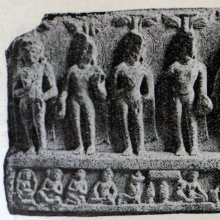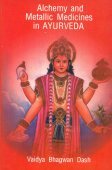Manushi, Mānusī, Mānuṣī, Manuṣī, Maṉuṣi: 18 definitions
Introduction:
Manushi means something in Buddhism, Pali, Hinduism, Sanskrit, Marathi, Jainism, Prakrit, Hindi, Tamil. If you want to know the exact meaning, history, etymology or English translation of this term then check out the descriptions on this page. Add your comment or reference to a book if you want to contribute to this summary article.
The Sanskrit terms Mānuṣī and Manuṣī and Maṉuṣi can be transliterated into English as Manusi or Manushi, using the IAST transliteration scheme (?).
Images (photo gallery)
In Hinduism
Natyashastra (theatrics and dramaturgy)
Source: Wisdom Library: Nāṭya-śāstraMānuṣī (मानुषी, “human”) is a Sanskrit technical term used in plays and dramas (nāṭya), as explained in the Nāṭyaśāstra.

Natyashastra (नाट्यशास्त्र, nāṭyaśāstra) refers to both the ancient Indian tradition (shastra) of performing arts, (natya—theatrics, drama, dance, music), as well as the name of a Sanskrit work dealing with these subjects. It also teaches the rules for composing Dramatic plays (nataka), construction and performance of Theater, and Poetic works (kavya).
Purana and Itihasa (epic history)
Source: Wisdom Library: Varāha-purāṇaMānuṣī (मानुषी).—Name of a river (nadī) situated near the seven great mountains on the western side of mount Naiṣadha, according to the Varāhapurāṇa chapter 83. These settlements consume the water flowing from these seven great mountains (Viśākha, Kambala, Jayanta, Kṛṣṇa, Harita, Aśoka and Vardhamāna). Niṣadha (Naiṣadha) is one of the seven mountains located in Jambūdvīpa, ruled over by Āgnīdhra, a grandson of Svāyambhuva Manu, who was created by Brahmā, who was in turn created by Nārāyaṇa, the unknowable all-pervasive primordial being.
Source: Cologne Digital Sanskrit Dictionaries: The Purana IndexMānuṣī (मानुषी).—A river of the Ketumālā country.*
- * Vāyu-purāṇa 44. 22.

The Purana (पुराण, purāṇas) refers to Sanskrit literature preserving ancient India’s vast cultural history, including historical legends, religious ceremonies, various arts and sciences. The eighteen mahapuranas total over 400,000 shlokas (metrical couplets) and date to at least several centuries BCE.
Ayurveda (science of life)
Source: gurumukhi.ru: Ayurveda glossary of termsMānuṣī (मानुषी):—One of the four categories of medicines described in Atharva veda.

Āyurveda (आयुर्वेद, ayurveda) is a branch of Indian science dealing with medicine, herbalism, taxology, anatomy, surgery, alchemy and related topics. Traditional practice of Āyurveda in ancient India dates back to at least the first millenium BC. Literature is commonly written in Sanskrit using various poetic metres.
Arthashastra (politics and welfare)
Source: Brill: Śaivism and the Tantric Traditions (artha)Mānuṣī (मानुषी) refers to “human”, according to the Arthaśāstra verse 1.9.9-10.—Accordingly, “He should appoint as chaplain a man who comes from a very distinguished family and has an equally distinguished character, who is thoroughly trained in the Veda together with the limbs, in divine omens, and in government, and who could counteract divine and human (mānuṣī) adversities through Atharvan means. He should follow him as a pupil his teacher, a son his father, and a servant his master”.

Arthashastra (अर्थशास्त्र, arthaśāstra) literature concerns itself with the teachings (shastra) of economic prosperity (artha) statecraft, politics and military tactics. The term arthashastra refers to both the name of these scientific teachings, as well as the name of a Sanskrit work included in such literature. This book was written (3rd century BCE) by by Kautilya, who flourished in the 4th century BCE.
In Buddhism
Tibetan Buddhism (Vajrayana or tantric Buddhism)
Source: archive.org: The Indian Buddhist IconographyMānuṣī (मानुषी) refers to the “Seven Mortal Buddhas” whose names appear last in the list of thirty-two Buddhas in Mahāyāna Buddhism.—The last seven Tathāgatas are well-known, and are designated by the Mahāyānist as Mānuṣī or “Mortal Buddhas”. When represented, the last seven Mortal Buddhas appear all alike; they are of one colour and one form, usually sitting cross-legged,with the right hand disposed in the Bhūmisparśa-mudrā (earth-touching attitute), which is the mudrā peculiar to Akṣobhya. [...] In paintings, the Mortal Buddhas they have usually a yellow or golden complexion. [...] Sometimes they are represented as standing, in which case the appear under a distinguishing Bodhi Tree and with a distinguishing mudrā.
Like the Dhyāni Buddhas, the Mortal Buddhas (mānuṣī) have also their respective Buddhaśaktis through whom they obtained the seven Mortal Bodhisattvas.
The seven mortal Buddhas (mānuṣī) together with their Buddhaśakti and Bodhisattva are named as follows:
- Vipaśyī (Vipasyantī—Mahāmati),
- Śikhī (Śikhimālinī—Ratnadhara),
- Viśvabhū (Viśvadharā—Ākāśagañja),
- Krakucchanda (Kakudvatī—Śakamaṅgala),
- Kanakamuni (Kaṇṭhamālinī—Kanakarāja),
- Kaśyapa (Mahīdharā—Dharmadhara),
- Śākyasiṃha (Yaśodharā—Ānanda).

Tibetan Buddhism includes schools such as Nyingma, Kadampa, Kagyu and Gelug. Their primary canon of literature is divided in two broad categories: The Kangyur, which consists of Buddha’s words, and the Tengyur, which includes commentaries from various sources. Esotericism and tantra techniques (vajrayāna) are collected indepently.
Languages of India and abroad
Pali-English dictionary
Source: BuddhaSasana: Concise Pali-English Dictionarymānusī : (f.) a woman.

Pali is the language of the Tipiṭaka, which is the sacred canon of Theravāda Buddhism and contains much of the Buddha’s speech. Closeley related to Sanskrit, both languages are used interchangeably between religions.
Marathi-English dictionary
Source: DDSA: The Aryabhusan school dictionary, Marathi-Englishmānuṣī (मानुषी).—f A woman. a Human.
Marathi is an Indo-European language having over 70 million native speakers people in (predominantly) Maharashtra India. Marathi, like many other Indo-Aryan languages, evolved from early forms of Prakrit, which itself is a subset of Sanskrit, one of the most ancient languages of the world.
Sanskrit dictionary
Source: DDSA: The practical Sanskrit-English dictionaryManuṣī (मनुषी).—A female, a woman.
Source: Cologne Digital Sanskrit Dictionaries: Shabda-Sagara Sanskrit-English DictionaryManuṣī (मनुषी).—f. (-ṣī) A woman, the wife or female of the man. E. manuṣya a man, and ṅīṣ aff.
Source: Cologne Digital Sanskrit Dictionaries: Monier-Williams Sanskrit-English Dictionary1) Manuṣī (मनुषी):—[from manuṣa > man] f. a woman, [cf. Lexicographers, esp. such as amarasiṃha, halāyudha, hemacandra, etc.]
2) Mānuṣī (मानुषी):—[from mānuṣa] f. a woman, [Mahābhārata; Kāvya literature] etc.
3) [v.s. ...] ([scilicet] cikitsā), ‘human medicine’, a branch of med°, the administering of drugs (opp. to āsurī and daivīcik), [Horace H. Wilson]
Source: Cologne Digital Sanskrit Dictionaries: Yates Sanskrit-English DictionaryManuṣī (मनुषी):—(ṣī) 3. f. A woman.
Source: DDSA: Paia-sadda-mahannavo; a comprehensive Prakrit Hindi dictionary (S)Mānuṣī (मानुषी) in the Sanskrit language is related to the Prakrit word: Māṇusī.
[Sanskrit to German]
Sanskrit, also spelled संस्कृतम् (saṃskṛtam), is an ancient language of India commonly seen as the grandmother of the Indo-European language family (even English!). Closely allied with Prakrit and Pali, Sanskrit is more exhaustive in both grammar and terms and has the most extensive collection of literature in the world, greatly surpassing its sister-languages Greek and Latin.
Hindi dictionary
Source: DDSA: A practical Hindi-English dictionaryMānuṣī (मानुषी):—(a) human, pertaining or befitting a human being; (nf) a woman.
...
Prakrit-English dictionary
Source: DDSA: Paia-sadda-mahannavo; a comprehensive Prakrit Hindi dictionaryMāṇusī (माणुसी) in the Prakrit language is related to the Sanskrit word: Mānuṣī.
Prakrit is an ancient language closely associated with both Pali and Sanskrit. Jain literature is often composed in this language or sub-dialects, such as the Agamas and their commentaries which are written in Ardhamagadhi and Maharashtri Prakrit. The earliest extant texts can be dated to as early as the 4th century BCE although core portions might be older.
Kannada-English dictionary
Source: Alar: Kannada-English corpusMānuṣi (ಮಾನುಷಿ):—[noun] = ಮಾನಸಿ [manasi].
Kannada is a Dravidian language (as opposed to the Indo-European language family) mainly spoken in the southwestern region of India.
Tamil dictionary
Source: DDSA: University of Madras: Tamil LexiconMaṉuṣi (மனுஷி) noun < mānuṣī. Woman; பெண்பிள்ளை. [penpillai.]
Tamil is an ancient language of India from the Dravidian family spoken by roughly 250 million people mainly in southern India and Sri Lanka.
See also (Relevant definitions)
Starts with: Manushibhu, Manushibuddha, Manushik, Manushikam, Manushivisha, Manushiyam, Manusika.
Ends with: Amanushi, Daivamanushi, Devamanushi, Jalamanushi, Kshirabdhimanushi, Nirmanushi, Payomanushi, Periyamanushi, Vanamanushi, Varmanushi.
Full-text (+45): Manusha, Payomanushi, Manushibuddha, Kshirabdhitanaya, Manushibhu, Nirmanushikri, Amanushi, Vanamanushi, Jalamanushi, Kshirabdhimanushi, Periyamanushi, Etadiya, Samajna, Arupa, Gautama, Shikhi, Vishvabhu, Shikhimalini, Kanthamalini, Krakucchanda.
Relevant text
Search found 21 books and stories containing Manushi, Maanushi, Mānusī, Mānuṣī, Manusi, Manuṣī, Māṇusī, Mānuṣi, Maṉuṣi; (plurals include: Manushis, Maanushis, Mānusīs, Mānuṣīs, Manusis, Manuṣīs, Māṇusīs, Mānuṣis, Maṉuṣis). You can also click to the full overview containing English textual excerpts. Below are direct links for the most relevant articles:
Rig Veda (translation and commentary) (by H. H. Wilson)
Shrimad Bhagavad-gita (by Narayana Gosvami)
Verse 9.11 < [Chapter 9 - Rāja-guhya-yoga (Yoga through the most Confidential Knowledge)]
Garga Samhita (English) (by Danavir Goswami)
Verse 4.9.7 < [Chapter 9 - The Glories of Srī Ekādaśī]
The gods of northern Buddhism (by Alice Getty)
Taittiriya Upanishad Bhashya Vartika (by R. Balasubramanian)
The Indian Buddhist Iconography (by Benoytosh Bhattachacharyya)
Related products


